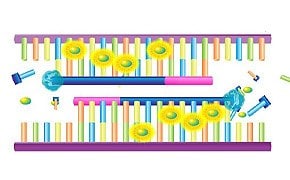定量PCR(qPCR)

实时定量PCR(qPCR)利用荧光报告分子对被扩增的产物进行定量分析。与传统PCR方法相同,qPCR会对某个DNA、cDNA或者RNA模版链进行扩增,但不同的是,在每一个循环中,都会监测荧光信号以进行相对或绝对的定量分析。在基因表达分析、基因型分型、微RNA分析、遗传变异分析以及蛋白分析等领域都发挥着重要作用。
如何分析 qPCR 数据
一般通过插入双链DNA碱基中的染色剂(如SYBR ® GREEN、溴化乙錠)或能结合到DNA特定序列上的探针(如分子灯塔、TaqMan®探针)对报告分子的荧光强度进行检测并定量。
qPCR 数据的相对量化
定量分析qPCR数据主要有两种方法。第一种是最常用的相对定量分析,通过分析ΔΔCt的信息,可比较目标基因与参考基因并利用参考基因的表达比例进行归一处理,从而确定目标基因的表达量或丰度。鉴于目标基因和参考基因的效率E值不同,该方法还可分析E值的差异。在基因表达分析中该方法更为常用。
qPCR 数据的绝对量化
第二种是绝对定量分析,利用标准曲线(SC)法进行定量分析,常用于环境微生物学。SC法是对已知浓度的模版N0进行梯度稀释,从而建立log(N0)对CT(循环阈值)的线性回归标准曲线,然后可用于计算样品中模版的浓度。使用该方法,一定要保证样品和标准曲线中的效率值相同。
相关技术文章
- After a traditional PCR has been completed, the PCR/qPCR data analysis is conducted by resolution through an agarose gel or, more recently, through a capillary.
- Real-time polymerase chain reaction allows researchers to estimate the quantity of starting material in a sample. It has a much wider dynamic range of analysis than conventional PCR
- PCR assay guide navigates you through primer validation and other assay optimization factors to ensure high sensitivity and specificity for optimum DNA/ RNA quantification.
- The entire PCR workflow is vulnerable to factors which introduce variability. Many of the variable components are unavoidable, such as the source of the sample or the requirement for a reverse transcription step. Assay design is also highly variable and can make the difference between PCR success and failure and also contributes to the reproducibility and sensitivity of an assay.
- Dual-Labeled Probes are the most common probe type for qPCR and are often referred to as hydrolysis probes.
- 查看完整内容 (39)
相关实验方案
- Our SYBR Green qPCR Protocol is a method designed to detect accurate quantification of gene expression and RT-PCR reactions
- Chromatin Immunoprecipitation quantitative real-time PCR (ChIP-qPCR) is commonly used in studies that focus on specific genes and potential regulatory regions across differing experimental conditions and data analysis. qPCR enables DNA analysis in real time by analyzing fluorescent signal intensities that are proportional to the amount of amplicon.
- Primer Concentration Optimization Protocol is an approach to create a matrix of reactions. This is used to test a range of concentrations for each primer against different concentrations of the partner primer.
- Once an assay has been optimized, it is important to verify the reaction efficiency. This information is important when reporting and comparing assays. In this example protocol, the assay efficiency is compared over a wide and narrow dynamic range of cDNA concentrations.
- Multiplex qPCR employing probe-based chemistries is a demanding application that often requires extensive optimization and validation.
- 查看完整内容 (32)
登入以繼續
若要繼續閱讀,請登入或建立帳戶。
還沒有帳戶?